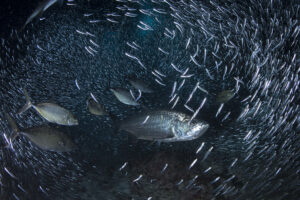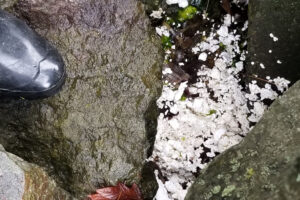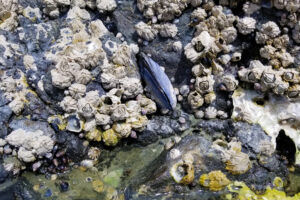Imagine you are a Coho salmon.
You were born in a gravely nest called a redd in Longfellow Creek, a small stream that flows through a West Seattle neighborhood into the Duwamish River and then into Puget Sound.


You survived your first year in this freshwater creek then left the protection of its shady pools to move out to sea to swim with the big fish. For three to four years in the open ocean, you fed on plankton, shrimp, and smaller fish, avoided being eaten or caught by humans, and grew into a beautiful, mature fish.
You know your destiny. It’s somehow written in your DNA. When your time comes, you will travel many miles through the North Pacific Ocean, using the earth’s magnetic field like a compass and your sense of smell, back to Elliott Bay and up the Duwamish River. You will turn right at the mouth of Longfellow Creek, swim through an 800-yard culvert that blankets you in darkness as it allows you to pass under the Port of Seattle and a steel mill. You emerge in an urban creek that provides shaded, gravely beds and pools of gently flowing water – a perfect place for you to spawn. After all, you were born here – it must be okay.

If you are a female, you arrive bearing a few thousand eggs and just enough energy left to dig a redd in which to lay them. If you are male, you arrive ready to fertilize those eggs with your milt. You’ve worked hard for this moment – to fulfill your destiny, your responsibility to your species. When you have accomplished your mission, satisfied with your success, you will die, surrendering the nutrients in your body to fortify the stream and the plants and animals that live there.
That is what should happen. Instead, just hundreds of feet from your finish line, something trips you up. Maybe you smell it, maybe you don’t. But something is definitely wrong. You are suddenly confused. Disoriented. You seem to have forgotten how to swim, which means you can’t breathe. Gasping, you can go no further. You won’t create a redd. You won’t lay eggs or fertilize them. You will die with your destiny in sight, but out of reach.
Why? What happened? This desperate condition is an example of a kind of Pre-Spawn Mortality called Urban Runoff Mortality Syndrome.1 It happens when fish die just before they get a chance to spawn. In the case of Coho returning to Longfellow Creek, they die because they have been poisoned – by our stormwater runoff.
What is stormwater runoff?
When urban development replaces porous earth surfaces with hard, paved surfaces, rainwater and snowmelt can’t soak into the ground. The water that runs off of these surfaces is called stormwater runoff. To prevent flooding, communities often rely on a network of gutters and drains to divert runoff away from buildings and toward streams so it can flow away without damaging the built infrastructure.

Stormwater runoff brings two problems to local streams and rivers. First, the high volume of water carries a lot of energy that can erode stream banks and bottoms, destroying habitat. Second, the water picks up all manner of filth from our hard surfaces and carries it to our rivers and lakes.
Depending on the neighborhood, drains sometimes divert runoff into retention ponds to allow some pollutants to settle to the bottom before the water continues to local streams. But, many drains divert contaminated stormwater directly to streams.

What kind of filth?
Urban and suburban communities release a toxic brew of motor oil, antifreeze, fertilizers, pesticides, heavy metals, and other chemicals. These pollutants accumulate on hard surfaces such as roadways, sidewalks, parking lots, and roofs. Here in the Pacific Northwest, that accumulation is particularly heavy in the fall, after a summer season of lighter rainfall. When storms arrive in the late fall and early winter, stormwater rinses those pollutants from the watershed and washes them into our streams.
How do we know stormwater is to blame?
When we compare the mortality rates for Coho in urban creeks and rural creeks, there is a significant difference. In local urban creeks, the mortality rate has been as high as 80% in recent years versus only 1% in rural creeks.2 Stormwater may not be the only cause of death, but when scientists immersed fish in stormwater collected from our roadways, 100% of the fish died.3 Stormwater is the smoking gun. In fact, stormwater runoff is the biggest source of pollution in Puget Sound.4
Coho are the most vulnerable
Five salmon species return to local freshwater rivers and streams over the course of several months from June to December. Coho generally return to the Duwamish River in October and November. This timing often coincides with the first heavy rainstorms of the fall season.
For reasons unknown, the Coho appear to be more sensitive to the toxicity of the water than other salmon species are. A concentrated dose of our waste flows into these nurseries with stormwater at the same time that the Coho are returning. It poisons and kills adult fish before they can spawn.
Impact on other species
These Coho are the canaries in the coal mine. Their death is a warning sign that the larger ecosystem is being poisoned. Toxins contaminate the entire stream, then continue to flow into the Salish Sea where they contaminate its food web.
These toxins infiltrate all levels of the food web from plankton and shellfish up to the apex predators such as orcas and humans. Washington Department of Fish and Wildlife has found these toxins in the mussels of Puget Sound. (See my post entitled What mussels can tell us about water quality.) Toxins in our Southern Resident Killer Whales (SRKWs) cause a long list of problems including endocrine disorders, reproductive dysfunction, a compromised immune system, and cancer.5 (See my post entitled Welcome baby orca J57!.) And of course, as we eat food from the Salish Sea, we are consuming these toxins, too.

What can we do?
Start by giving credit where credit is due. State and local governments, civil engineers, scientists, and neighborhood residents have made huge strides in setting regulations and implementing solutions intended to clean our stormwater. If you look around our communities you will see retention ponds, rain gardens, and bioswales designed to slow and filter the flow before it hits our streams. There is also a lot of engineering you can’t see, beneath commercial parking lots and city streets. (I will focus another article on the good work they have done so far and what we should consider doing next.)
Despite these efforts, we haven’t solved the problem yet. We need to do more to improve wastewater quality to protect fish habitat. To do this, we need to 1) change our behavior and 2) change our infrastructure – faster:
Change our behavior to reduce pollutants entering stormwater.
- Prevent liquid and solid waste from entering gutters or stormwater drains. Review your city’s or county’s website for disposal options, such as the Hazardous Waste Management Program for King County.
- Use commercial car washes that collect and recycle dirty water.
- Fix leaks in your car to keep oil, antifreeze, and other fluids from landing on the pavement.
- Use compost or non-toxic fertilizers and pesticides in your garden or on your farm.
- Pick up your pet’s waste and put it in the trash bin, not the compost bin.
- Tell your elected officials to stand up for the US Clean Water Act, the US Endangered Species Act, and to strengthen the requirements of Washington State’s toxic clean-up program, the Model Toxics Control Act (MTCA).
Change our infrastructure so that it replaces the flood control and filtration services that the forests originally provided before our communities were built.
- Build a rain garden on your property to capture runoff from your roof to allow water to slowly seep into the soil and be filtered naturally. Get started with this Rain Garden Handbook from the Washington Department of Ecology.
- Construct hard surfaces such as sidewalks and parking lots with pervious concrete or asphalt that allows water to seep into the soil underneath.
- Create bioswales next to roadways, parking lots, or sidewalks that can’t be made porous to capture runoff and allow it to seep into the soil.
- Avoid building too close to the streams and rivers, providing healthy buffer zones, called riparian borders, that can filter urban runoff before it enters a stream.
Go Deeper!
Go Deeper to explore the ocean and the Salish Sea through a curated list of articles, books, films, and other resources.
To learn more about the topic in this article, check out the following resources:
- Broken Fish: Collapse of the Coho | 2018 Short Film (runtime 00:14:35)
- Coho Urban Runoff Mortality Syndrome in Puget Sound (runtime 00:05:52)
- Coho Pre-Spawn Mortality on Longfellow Creek (PDF)
- Innovative Stormwater Management at the Neighbourhood Scale (runtime 00:14:18)
- Rain Garden Handbook for Western Washington (PDF)
- Hazardous Waste Management Program in King County
- Stormwater services and information in King County
Acknowledgments
- Thanks to Eiko Jones for his permission to use these beautiful images of Coho salmon. Please visit Eiko Jones Photography to see his full portfolio.
- Thanks to Molly Allen for reviewing and improving this post.
End Notes
1-3 “Introduction.” Coho Urban Runoff Mortality Syndrome in Puget Sound, Washington Fish and Wildlife Office, NOAA, Washington State University, The Nature Conservancy, 2019, fws.maps.arcgis.com/apps/MapSeries/index.html?appid=5dd4a36a2a5148a28376a0b81726a9a4.
4 University, Washington State. “Natural Filtration Helps Protect Salmon | Provided by Washington State University.” The Seattle Times, The Seattle Times Company, 11 Apr. 2016, www.seattletimes.com/sponsored/natural-filtration-helps-protect-salmon/.
5 Fisheries, NOAA. “Toxic Killer Whales.” NOAA, 28 Aug. 2019, www.fisheries.noaa.gov/feature-story/toxic-killer-whales.






Leave a Reply
Your comments are welcome.